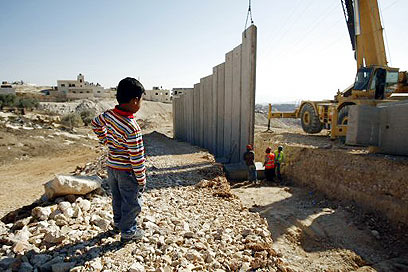
I put my hand out to signal the bust to stop. The people sitting at the bus stop under the bridge at the French Hill neighborhood look at me baffled and surprised. I go on the minibus with the green lines at the front and the number 74 above them. The bus is going to Beit Hanina. It's going fast and stops every few minutes, not at the regular bus stops but when people standing on the sidewalk signal it. Accordingly, the passengers on the bus who wish to get off press the yellow "Stop" button and the driver pulls over immediately, without any stops or delays.
Most of the people living in western Jerusalem have never once visited eastern Jerusalem. This, of course, does not include the market in the Old City, which everyone considers as "east Jerusalem". I mean the eastern neighborhoods like Ras al-Amud, Silwan, Beit Hanina, Shoafat, the Anata refugee camp and a-Tur.
Every day in the last month I have been going to east Jerusalem. The reason is irrelevant. I get there every day and feel like I have landed in a foreign place, went through an invisible terminal filled with invisible people. The streets look like the streets of an Arab city, lacking in resources and empty of hope.
The trash on the streets is never picked up; not manually by cleaning people, and obviously not by a special street cleaning machine. The roads are cracked and full of holes, and so the small, unventilated buses (that are designed to carry up to 10 people, but usually drive about 20) always bump into them, never missing a single crack.
The traffic lights also seem to be working against the residents of east Jerusalem. It appears that in every central intersection that borders west Jerusalem, the lights are programmed to allow convenient passage for Jewish cars, causing long lines of east city vehicles waiting for the lights to change.
Sense of violence and helplessness
Naturally, things that can be seen from here cannot b seen from the western part of the capital. The huge separation wall that divides the West Bank can be seen from the street. The residents of west Jerusalem will likely never see how this wall cuts through the houses and yards of private people whose land has been confiscated. Many will never know and feel the sense of violence and helplessness such a wall in the heart of the city creates.

Separation wall in east Jerusalem (Photo: Reuters)
Every morning I ride to east Jerusalem, see different people, who on the streets of my city would have been invisible. Tired, downtrodden people. Here in their east Jerusalem homes they are the majority. They are the ones making the decisions, at least seemingly. They live like this without asking questions. A long time ago they have given up hoping they would be able to lead a normal life like in the western city: Without having power outages every hour, cutting off the slow internet connection at the few offices that have it; without having the sewage overflow and fill the streets with a terrible stench.
This is what a day in east Jerusalem looks like. And every day when I go to Beit Hanina I am filled with rage at the fact that my friends will never step foot there. They'll never see how different this place is from other cities, even from my city – west Jerusalem.
Repressing reality
This blatant discrimination against the residents of east Jerusalem pains me personally. I have friends in east Jerusalem, and every hole on the road or a power cut pains me, simply because it is so unfair. Because life in west Jerusalem seems so different, just like being abroad.
All those Jerusalemites like myself, who grew up in the city and believe they know it inside out, are wrong. I've been living in Jerusalem for 20 years; living it like it's a part of my body, like every other Jerusalemite who hates and loves the city and chooses to stay her despite everything, feels.
But unfortunately, even Jerusalemites don't really know the real Jerusalem. The real Jerusalem is a five-minute drive from the French Hill, 15-minute drive from the dorms of Mount Scopus and six-minute drive from the entrance to Pisgat Ze'ev. The real Jerusalem is this difference – the discrimination that for 32 years has allowed repressing the other half of the city outside Jerusalem's consciousness, and at the same time to celebrate the city's reunification every year.
The writer is a student at the Hebrew University in Jerusalem















